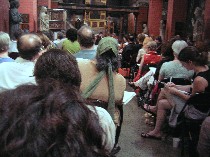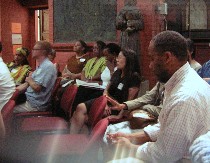
The ladies do not like to take meetings. But the LINC meeting at Fleisher yesterday (see Roberta’s previous post) had a lot going on. Besides, we got to see and meet lots of people (there were more than 150 people attending!). Everyone who showed up is on our list of good citizens who want to make the art life better for all involved, all including dancers, actors, video artists–everyone in the arts (in the Fleisher chapel, early in the day).
LINC presenters told us about programs their own cities developed, and here are my brief-brief versions of the presenter highlights:
Los Angeles
Los Angeles’ pool of art and art makers is huge (think about the movie industry, guys), but so many are not successful.
Judith Luther Wilder at the Center for Cultural Innovation, who has a business and entrepreneurial background, set up a program to give artists entrepreneurial training.
She said they made it clear to the artists that “Nothing we were doing was going to make them better artists.”
Their core of counselors including attorneys, cpas, producers, museum directors, and for a small fee, artists can come to them for advice. “All these people had to be bilingual,” she said, comfortable in the language of the arts and comfortable in the language of their own fields.
The students didn’t think they needed entrepreneurial training, but the 30 years olds loved it.
Other parts of the program there included setting up a benefits program by forming an alliance with school alumni associations, including Cal Arts alumni to create a pool of 40,000 people.
They also set up a collateral pool for artists for when they need a mortgage or other loan.
Minneapolis
Artspace is a 25-year-old non-profit that aims to change the pattern in which artist move into an area, fix it up and then get priced out of their space. So Artspace creates spaces dedicated only to artists. One of their projects is now across from where the Minnesota Twins wanted to build their new ball park. The land is worth $24 million, but the artists are still there, still paying $664/month.
Chris Velasco, who made this presentation, is now working with the William Penn Foundation, exploring how to provide space for artists in Philadelphia. So if you get a survey from William Penn, now you know why.
Seattle
Sam Miller from LINC Boston explained how Seattle’s artists community convinced state government to use artists as a demonstration group to work out a program that would insure the underinsured–all self-imployed, uninsured workers. Their baseline was it had to provide catastrophic care because 45 percent of bankruptcies of small businesses are due to catastrophic healthcare expenses.
Rhode Island
 The lesson here, delivered by Ann Galligan of Northeastern University in Boston is that tax credits for artists work. duh. Are you listening, dear Mayor Street? Artists are workers, creative workers. So Providence created a no-tax zone for artists modeled on Ireland’s Temple Bar tax incentives. No sales tax on art generated in the zone. No personal income tax for artists in the zone. And preservation credits for the buildings. Ironically, the artists still couldn’t afford the downtown area in the zone, but the buzz attracted them to the area around it (right, at Fleisher at the end of a long day of meetings).
The lesson here, delivered by Ann Galligan of Northeastern University in Boston is that tax credits for artists work. duh. Are you listening, dear Mayor Street? Artists are workers, creative workers. So Providence created a no-tax zone for artists modeled on Ireland’s Temple Bar tax incentives. No sales tax on art generated in the zone. No personal income tax for artists in the zone. And preservation credits for the buildings. Ironically, the artists still couldn’t afford the downtown area in the zone, but the buzz attracted them to the area around it (right, at Fleisher at the end of a long day of meetings).Pawtucket, Rhode Island
Got a problem with City Hall? Need to find a studio with a loading dock? In Pawtucket it’s one-stop shopping. Herb Weiss, from the Office of Economic and Cultural Affairs in Pawtucket, is your go-to guy. He will help. He will print out a list of properties for sale that fit your needs. He will find the government agency who can help you.
The next step is to see what Philadelphia artists think are their biggest problems and to then work on solutions. Meanwhile, it was good to learn that a number of simultaneous efforts are going on, between Pew and the LINC project, and the William Penn Foundation effort.
I’m leaving the rest for Roberta.









